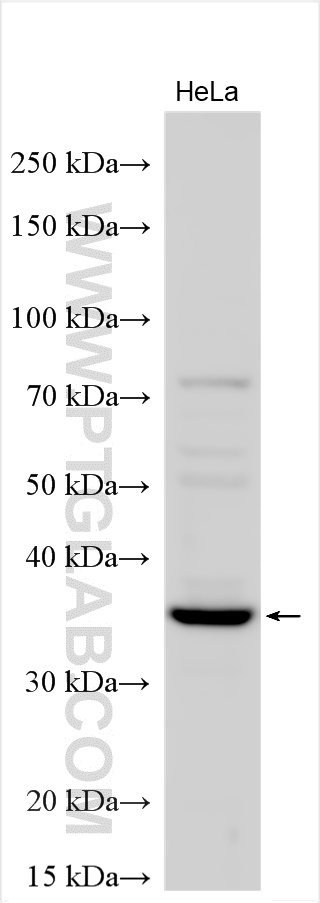DTWD1 Polyclonal antibody
DTWD1 Polyclonal Antibody for WB, ELISA
Host / Isotype
Rabbit / IgG
Reactivity
human
Applications
WB, ELISA
Conjugate
Unconjugated
验证数据展示
经过测试的应用
| Positive WB detected in | HeLa cells |
推荐稀释比
| Application | Dilution |
|---|---|
| Western Blot (WB) | WB : 1:500-1:2000 |
| It is recommended that this reagent should be titrated in each testing system to obtain optimal results. | |
| Sample-dependent, Check data in validation data gallery. | |
发表文章中的应用
| WB | See 1 publications below |
产品信息
26810-1-AP targets DTWD1 in WB, ELISA applications and shows reactivity with human samples.
| Tested Applications | WB, ELISA Application Description |
| Cited Applications | WB |
| Tested Reactivity | human |
| Cited Reactivity | human |
| Immunogen | DTWD1 fusion protein Ag25170 种属同源性预测 |
| Host / Isotype | Rabbit / IgG |
| Class | Polyclonal |
| Type | Antibody |
| Full Name | DTW domain containing 1 |
| Synonyms | DTW domain containing 1, DTWD1, MDS009 |
| Observed Molecular Weight | 35 kDa |
| GenBank Accession Number | BC032535 |
| Gene Symbol | DTWD1 |
| Gene ID (NCBI) | 56986 |
| RRID | AB_3085907 |
| Conjugate | Unconjugated |
| Form | Liquid |
| Purification Method | Antigen affinity purification |
| UNIPROT ID | Q8N5C7 |
| Storage Buffer | PBS with 0.02% sodium azide and 50% glycerol pH 7.3. |
| Storage Conditions | Store at -20°C. Stable for one year after shipment. Aliquoting is unnecessary for -20oC storage. |
背景介绍
DTW domain-containing protein 1 (DTWD1), also named as tRNA-uridine aminocarboxypropyltransferase 1, is responsible for 3-(3-amino-3-carboxypropyl)uridine modification at position 20 in the D-loop of certain tRNAs (PMID: 31804502; 37745798). DTWD1 has been identified as a target gene of p53 and functions as a tumor suppressor gene (PMID: 25973305). Dysregulated expression of DTWD1 has been reported in several malignancies, including gastric cancer and colorectal cancer (PMID: 25973305; 31924336).
实验方案
| Product Specific Protocols | |
|---|---|
| WB protocol for DTWD1 antibody 26810-1-AP | Download protocol |
| Standard Protocols | |
|---|---|
| Click here to view our Standard Protocols |
